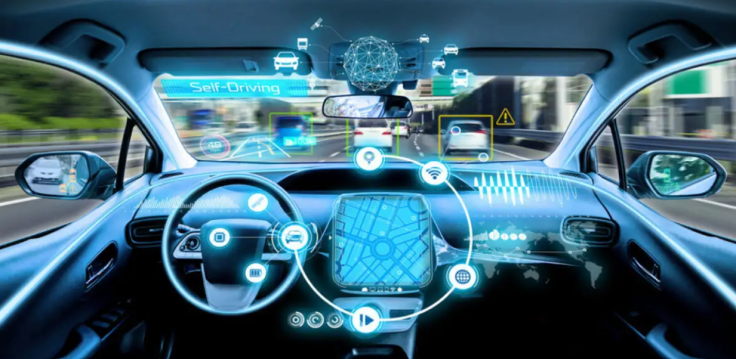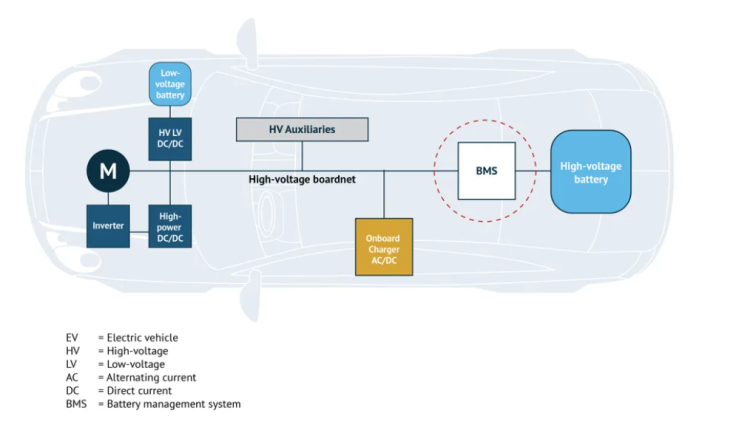Driving Innovation: Patents And Projects Shaping The Automotive Industry
Engineers and innovators play a critical role in expanding the possibilities of what vehicles can achieve

The automotive industry has experienced significant advancements over the past few decades, characterized by key technological developments that have redefined transportation. The implementation of digital technologies and smart systems has been crucial in this progression, enabling cars to become not just modes of transport but sophisticated machines capable of interacting with their surroundings and enhancing the overall driving experience.
Continual innovation remains at the heart of the automotive industry. Engineers and innovators play a critical role in expanding the possibilities of what vehicles can achieve. One such figure is Chirag Shah, whose work in digital speedometers, wheel rim configurations, and battery management systems stands as a testament to the power of innovation in transforming the automotive sector. Chirag's dedication to leveraging advanced technologies to solve complex challenges underscores the importance of innovation in maintaining the industry's momentum and enabling future advancements.
Inspiration Behind Patents
The genesis of patents like the Digital Speedometer and Digital Wheel Rim Configuration lies in Chirag's deep passion for automotive technology. His journey into creating a more precise digital speedometer was driven by understanding human psychology and the importance of accurate speed monitoring for safety. "I recognized that traditional analog and even some digital speedometers often display speeds slightly higher than the actual speed," Chirag explains, "influencing drivers to maintain control and stay within safe limits." His expertise in embedded software development and system simulation was pivotal in achieving a speedometer that integrates seamlessly with modern vehicle systems, providing reliable performance across various driving conditions.
In the context of the Digital Wheel Rim Configuration, Chirag envisioned merging aesthetics with advanced technology to elevate vehicle performance. Inspired by the potential of using cutting-edge materials and sleek designs to reduce weight and improve aerodynamics, Chirag aimed to enhance fuel efficiency. Additionally, by incorporating digital displays into the rims to monitor tire pressure, temperature, and performance metrics, Chirag sought to offer drivers better control and customization options. His work reflects a commitment to pushing the boundaries of automotive engineering, blending innovation with practical functionality to significantly enhance vehicle safety, performance, and the user experience.
Motivation For Writing On AI in Automotive Safety
Chirag's motivation for writing "Vehicle Safety Using Artificial Intelligence" and "The Future of Transportation: Innovations in the Automotive Industry Using AI/ML" is deeply rooted in his extensive experience and dedication to advancing the automotive industry. With a robust background in embedded software development, controls integration, and system simulation, Chirag has witnessed firsthand the transformative power of AI in enhancing vehicle safety and efficiency. He was driven to explore and document the revolutionary ways AI can optimize real-time data processing from vehicle sensors, significantly improving decision-making in both autonomous and semi-autonomous vehicles. Chirag states his goal was to create a resource that outlines current technological advancements and provides a broader vision of ultimately aiming to reduce accidents and save lives. "Writing this book allowed me to merge my technical expertise with a broader vision of creating safer roadways for everyone," Chirag explains, underscoring his commitment to leveraging AI for significant safety improvements.
In "The Future of Transportation: Innovations in the Automotive Industry Using AI/ML," Chirag delves into the technological revolution within the automotive sector, showcasing how AI and ML are being integrated into various facets of transportation. He emphasizes the transformative potential of these technologies in creating smarter, more efficient, and environmentally sustainable transportation systems. By sharing his insights and experiences, Chirag hopes to inspire others in the industry to explore the limitless possibilities of AI and ML, reflecting his belief in the power of technology to drive positive change in the automotive industry. Through his writings, he aims to equip professionals, policymakers, and technologists with the knowledge needed to navigate and thrive in this rapidly evolving landscape.

Challenges In Battery Management System Projects
Ensuring the reliability and safety of the batteries under various operating conditions was paramount in Chirag's work on Battery Management Systems (BMS) for Electric Vehicles (EVs) at General Motors. A key issue was accurately monitoring and controlling the battery's state of charge, state of health, and state of life to prevent failures or hazardous situations. Chirag employed advanced monitoring techniques using both analog and digital sensors, coupled with microcontrollers, to gather real-time data on crucial parameters like voltage, current, and ambient temperature. This approach was vital in maintaining the battery's optimal state. Chirag reflects, "One of the biggest challenges was ensuring the BMS could handle diverse conditions reliably—our focus was on precision and safety at all times."
Another major challenge Chirag faced was developing algorithms for accurate range prediction based on battery degradation and vehicle mileage. This was critical to improving the overall performance and reliability of EVs. Through thorough analysis and simulation of battery degradation patterns, Chirag enhanced the accuracy of range predictions, leading to more reliable EVs. He also played a pivotal role in developing a robust simulation framework, which supported co-simulation and virtual vehicle integration, significantly improving the development and testing processes. His strategic problem-solving and collaboration with cross-functional teams were essential in overcoming these challenges, ultimately resulting in more efficient and reliable battery management systems for EVs.
Impact of GM Service Milestone Recognition
Receiving GM's Service Milestone Recognition has profoundly influenced Chirag's approach to work and innovation, serving as both validation and motivation. This acknowledgment reinforces his commitment to excellence, encouraging him to uphold high standards in every endeavor. As Chirag reflects, "Being recognized for my dedication and contributions instills a sense of pride and responsibility, driving me to push boundaries and explore new, innovative solutions."
The recognition also boosts Chirag's confidence in leading projects and collaborating across teams, empowering him to tackle complex challenges with renewed enthusiasm. It acts as a reminder of the critical role of teamwork, motivating him to foster an environment where ideas can be exchanged freely and solutions developed efficiently. This collaborative spirit is crucial for innovation, as it brings together diverse perspectives and expertise, resulting in more robust and creative outcomes. Ultimately, this recognition inspires Chirag to continuously seek improvements, setting higher goals and embracing advancements in technology.
Methodologies For Manufacturing Efficiency
In his conference presentation, Chirag underscored the importance of precision and closing gaps in car manufacturing by proposing several impactful methodologies. One key approach was the implementation of Statistical Quality Control (SQC) techniques, which Chirag explained are essential for real-time monitoring and controlling of the manufacturing process. "By utilizing tools such as control charts and analysis of variance, we can identify variations and potential defects, allowing for immediate corrective actions," Chirag noted. This method significantly enhances product consistency and quality, reducing defects and the need for rework.
Chirag also highlighted the role of Design of Experiments (DOE) in optimizing manufacturing parameters. By systematically varying key process parameters, DOE helps in identifying the optimal conditions for production, thereby improving both product quality and process efficiency. Additionally, Chirag emphasized the adoption of advanced metrology techniques, such as laser scanning and coordinate measuring machines, to ensure precise alignment and placement of components. These methodologies collectively contribute to higher customer satisfaction, reduced warranty claims, and overall success in the automotive manufacturing industry.
AI-enabled Quality Control
AI-enabled quality control in automobile manufacturing, as demonstrated by Chirag's work, significantly enhances the precision and efficiency of gap control processes. AI's ability to analyze vast amounts of data collected from sensors and cameras in real-time plays a crucial role in detecting even the smallest deviations in gap measurements, which might be missed by human inspectors. "The real-time monitoring capability of AI systems ensures that any deviations are immediately flagged, allowing for prompt corrective actions," Chirag explains. This capability reduces defects and ensures products meet stringent quality standards.
Additionally, Chirag emphasizes the importance of AI-driven predictive analytics in preventing potential issues before they arise. By analyzing historical data, AI systems can identify patterns and alert the quality control team to make necessary adjustments, optimizing the manufacturing process and reducing waste. Furthermore, Chirag points out that automated inspection systems using AI algorithms offer a much faster and more consistent approach than manual inspections, significantly improving quality assurance. Chirag's insights highlight how AI integration leads to continuous improvement in manufacturing techniques, resulting in higher-quality products and more efficient production methods.

Advancements In Electric Vehicle Technology
Work on parallel flashing modules with VSPY at General Motors, led by Chirag, represents a significant advancement in electric vehicle technology, particularly in the area of vehicle electronics.The complexity of modern vehicles has increased dramatically, with dozens of computers interconnected in intricate networks, including main, sub, and multimedia networks. Chirag emphasizes the critical role of Vehicle Spy in navigating this complexity, stating, "Electronics in vehicles have grown to an unprecedented level of complexity, and Vehicle Spy helps tackle this challenge with tools designed for quick access to information and enhanced productivity."
Vehicle Spy's ability to design, test, and analyze these complex networked systems is essential for the development and verification of vehicle electronics, which are crucial for the functionality of electric vehicles. Chirag highlights that the software contains many tools to help users access information quickly, which is vital for efficient and accurate diagnostics and system optimization. This initiative not only improves the reliability and performance of electric vehicles but also streamlines the development process, making it easier to manage the sophisticated electronics integral to modern EVs.
Influence Of Six Sigma Certification On Leadership
Chirag's Design for Six Sigma Black Belt certification has been pivotal in shaping his approach to leadership and project management. This certification provided him with a solid framework and a variety of tools designed to enhance quality and efficiency in his projects. Through the use of methodologies like Fishbone diagrams and the 5 Whys, Chirag systematically identifies and addresses underlying issues, leading to more effective and sustainable solutions.
Chirag emphasizes the importance of the DMAIC methodology, a core aspect of Six Sigma, in his work. "By following the DMAIC steps, I'm able to structure projects effectively, set clear objectives, and implement targeted improvements," he explains. This methodical approach ensures that his projects consistently meet their goals while maintaining high standards of quality. His Six Sigma certification has, therefore, been a cornerstone in driving successful outcomes and fostering a culture of continuous improvement within his teams.
Chirag's contributions to automotive technology are notable not only for their ingenuity but also for their tangible impact on vehicle safety, efficiency, and functionality. His innovations, including the Digital Speedometer and the Digital Wheel Rim Configuration, reflect a deep understanding of both engineering principles and user needs. Chirag's work on the Battery Management System (BMS) has been critical in enhancing the reliability, safety, and performance of electric vehicles, demonstrating the advancements possible with modern automotive technology.
© Copyright IBTimes 2025. All rights reserved.




















